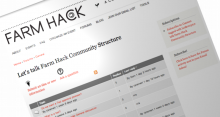Food Solutions New England (FSNE) is a regional food systems learning-action network dedicated to advancing a sustainable New England food system. The FSNE network is organized around four interrelated activities:
A New England Food Vision, a bold vision that calls for our region to build the capacity to produce up to 70% of food that is produced in an environmentally and socially sustainable manner, that promotes health and is accessible by all New Englanders by 2060; New England state food planning initiatives; annual New England food summits and topical workshops; and related analysis, communication and visualization.
The UNH Sustainability Institute serves as the backbone organization for FSNE. Since its inception in 2006, FSNE has advanced its mission by linking a common agenda, shared measurement, continuous communication, and synergestic activities.




I will try and add more to the the wiki later - but your description is pretty accurate. The vanes in the rotor spin the seeds out where they hit the stator (stationary ring. The hull is knocked off by the impact. In some impact dehullers I have seen, the stator is a stone like material, but the one documented here used a steel ring.
The seed/grotes and hulls are blown/expelled by the air movement caused by the rotation of the fins on the side of the rotor. The cyclone separator is designed to have a vacuum on the top to separate/winnow out the hulls and have the heavier seed drop down for collection. Alternatively the mixture can be collected and run through a fanning mill (which I will be documenting later this spring). A fanning mill screens for over and under size and separates by weight.
To hull barley or spelt more velocity is needed and a higher rotational speed. Hammers/impellers are also added to the rotor and a correctly sized screen is substituted for the stationary ring such that the hulled grain can be expelled, but the unhulled grain is beat up further until it is able to exit through the screens. I do not yet have any drawings of this feature.
It will be great to have this design into autodesk inventor. I hope that the sketchup drawings are helpful as a start. It needs some cleanup but I can save it in another format like 3ds for importing if it would be useful. My hope is that we can post machine files here too if you use a torch table or water jet etc. for cutting any of the pieces.